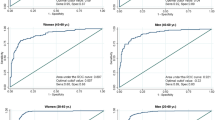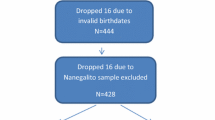Abstract
To define the factors that influence the development of metabolic syndrome (MetS) characteristics in adolescents, this study assessed the clustering pattern for MetS using confirmatory factor analysis (CFA). Components of metabolic syndrome, including abdominal obesity, insulin resistance, high blood pressure, and dyslipidemia, were analyzed in 1,514 Korean adolescents aged 10 to 18 years. The validities of one-factor models underlying a unifying etiology and a four-factor model based on more than one physiologic process for MetS across sex and age groups were assessed using the CFA method. The one-factor model, which incorporated waist circumference (WC), homeostasis model assessment-insulin resistance (HOMA-IR), systolic blood pressure (SBP), and high-density lipoprotein (HDL) values, had the best goodness-of-fit indices among the models (comparative fit index 0.99, root mean square error of approximation 0.04), with stability over sex and age groups. MetS was mainly defined by WC, SBP, HOMA-IR, and HDL values, with factor loadings of 0.78, 0.47, 0.44, and −0.37, respectively. WC contributed the most to MetS, with the highest factor loading value across sex and age groups. In conclusion, a single underlying factor representing the common pathway linking abdominal obesity, SBP, HOMA-IR, and HDL may explain MetS in Korean adolescents with stability across sex and age groups.

Similar content being viewed by others
References
Bu X, Warden CH, Xia Y-R, Meester C, Puppione DL, Teruya S, Lokensgard B, Daneshmand S, Brown J, Gray RJ, Rotter JI, Lusis AJ (1994) Linkage analysis of the genetic determinants of high density lipoprotein concentrations and composition: evidence for involvement of the apolipoprotein A-II and cholesteryl ester transfer protein loci. Hum Genet 93(6):639–648
Cook S, Weitzman M, Auinger P, Nguyen M, Dietz WH (2003) Prevalence of a metabolic syndrome phenotype in adolescents: findings from the third National Health and Nutrition Examination Survey, 1988–1994. Arch Pediatr Adolesc Med 157(8):821–827
Cruz ML, Huang TTK, Johnson MS, Gower BA, Goran MI (2002) Insulin sensitivity and blood pressure in Black and White children. Hypertension 40(1):18–22
Giordano P, Del Vecchio GC, Cecinati V, Delvecchio M, Altomare M, De Palma F, De Mattia D, Cavallo L, Faienza MF (2011) Metabolic, inflammatory, endothelial and haemostatic markers in a group of Italian obese children and adolescents. Eur J Pediatr 170(7):845–850
Goodman E, Dolan LM, Morrison JA, Daniels SR (2005) Factor analysis of clustered cardiovascular risks in adolescence: obesity is the predominant correlate of risk among youth. Circulation 111(15):1970–1977
Hanley AJG, Karter AJ, Festa A, D'Agostino R, Wagenknecht LE, Savage P, Tracy RP, Saad MF, Haffner S (2002) Factor analysis of metabolic syndrome using directly measured insulin sensitivity. Diabetes 51(8):2642–2647
Hoyle RH (1995) Structural equation modeling: concepts, issues, and applications. An introduction focusing on AMOS. Sage, Thousand Oaks
Hu L, Bentler PM (1999) Cutoff criteria for fit indexes in covariance structure analysis: conventional criteria versus new alternatives. Struct Equ Model 6:1–55
Jöreskog KG, Sörbom D (2001) Lisrel 8.5 for windows [computer software].
Kahn R, Buse J, Ferrannini E, Stern M (2005) The metabolic syndrome: time for a critical appraisal. Diabetes Care 28(9):2289–2304
Keskin M, Kurtoglu S, Kendirci M, Atabek ME, Yazici C (2005) Homeostasis model assessment is more reliable than the fasting glucose/insulin ratio and quantitative insulin sensitivity check index for assessing insulin resistance among obese children and adolescents. Pediatrics 115(4):e500–e503
Kim SM, Han JH, Park HS (2006) Prevalence of low HDL-cholesterol levels and associated factors among Koreans. Circ J 70(7):820–826
Korea Center for Disease Control and Prevention (2010) National Health and Nutrition Examination Survey: the 4th results report: 2008 National Health Statistics. Ministry of Health, Welfare and Family, Seoul
Kurtoğlu SHN, Mazıcıoğlu M, Kendirici M, Keskin M, Kondolot M (2010) Insulin resistance in obese children and adolescents: HOMA-IR cut-off levels in the prepubertal and pubertal periods. J Clin Res Pediatr Endocrinol 2(3):100–106
Lawlor DA, Ebrahim S, May M, Davey Smith G (2004) (Mis)use of factor analysis in the study of insulin resistance syndrome. Am J Epidemiol 159(11):1013–1018
Lee S, Bacha F, Gungor N, Arslanian SA (2006) Waist circumference is an independent predictor of insulin resistance in Black and White youths. J Pediatr 148(2):188–194
Lee JM, Okumura MJ, Davis MM, Herman WH, Gurney JG (2006) Prevalence and determinants of insulin resistance among U.S. adolescents. Diabetes Care 29(11):2427–2432
Li C, Ford ES (2007) Is there a single underlying factor for the metabolic syndrome in adolescents? Diabetes Care 30(6):1556–1561
Linton JA, Kimm H, Ohrr H, Park IS, Jee SH (2009) High-density lipoprotein-cholesterol and ischemic heart disease risk in Korean men with cardiac risk a prospective cohort study. Circ J 73(7):1296–1301
Martínez-Vizcaíno V, Martínez MS, Aguilar FS, Martínez SS, Gutiérrez RF, López MS, Martínez PM, Rodríguez-Artalejo F (2010) Validity of a single-factor model underlying the metabolic syndrome in children. Diabetes Care 33(6):1370–1372
Pladevall M, Singal B, Williams LK, Brotons C, Guyer H, Sadurni J, Falces C, Serrano-Rios M, Gabriel R, Shaw JE, Zimmet PZ, Haffner S (2006) A single factor underlies the metabolic syndrome. Diabetes Care 29(1):113–122
Reaven GM (1988) Banting lecture 1988. Role of insulin resistance in human disease. Diabetes 37(12):1595–1607
Rutherford JNMT, Feranil AB, Adair LS, Kuzawa CW (2010) High prevalence of low HDL-c in the Philippines compared to the US: population differences in associations with diet and BMI. Asia Pac J Clin Nutr 19(1):57–67
Sakkinen PA, Wahl P, Cushman M, Lewis MR, Tracy RP (2000) Clustering of procoagulation, inflammation, and fibrinolysis variables with metabolic factors in insulin resistance syndrome. Am J Epidemiol 152(10):897–907
Shen B-J, Goldberg RB, Llabre MM, Schneiderman N (2006) Is the factor structure of the metabolic syndrome comparable between men and women and across three ethnic groups: the Miami Community Health Study. Ann Epidemiol 16(2):131–137
Shen B-J, Todaro JF, Niaura R, McCaffery JM, Zhang J, Spiro Iii A, Ward KD (2003) Are metabolic risk factors one unified syndrome? Modeling the structure of the metabolic syndrome X. Am J Epidemiol 157(8):701–711
Steinberger J, Daniels SR, Eckel RH, Hayman L, Lustig RH, McCrindle B, Mietus-Snyder ML (2009) Progress and challenges in metabolic syndrome in children and adolescents: a scientific statement from the American Heart Association Atherosclerosis, Hypertension, and Obesity in the Young Committee of the Council on Cardiovascular Disease in the Young; Council on Cardiovascular Nursing; and Council on Nutrition, Physical Activity, and Metabolism. Circulation 119(4):628–647
Conflict of interest
Authors declare that they have no conflict of interest.
Author information
Authors and Affiliations
Corresponding author
Rights and permissions
About this article
Cite this article
Ko, M.J., Lee, E.Y. & Kim, K. Characteristics of metabolic syndrome based on clustering pattern among Korean adolescents: findings from the Korean National Health and Nutrition Examination Survey, 2007–2008. Eur J Pediatr 172, 193–199 (2013). https://doi.org/10.1007/s00431-012-1857-7
Received:
Accepted:
Published:
Issue Date:
DOI: https://doi.org/10.1007/s00431-012-1857-7




